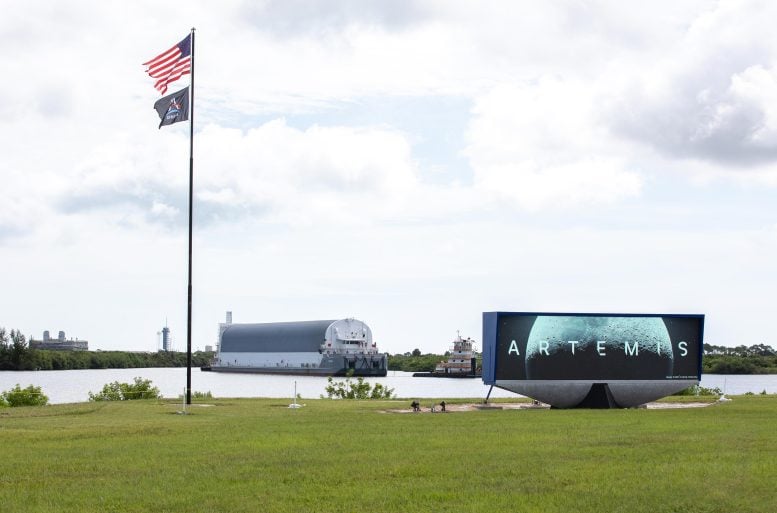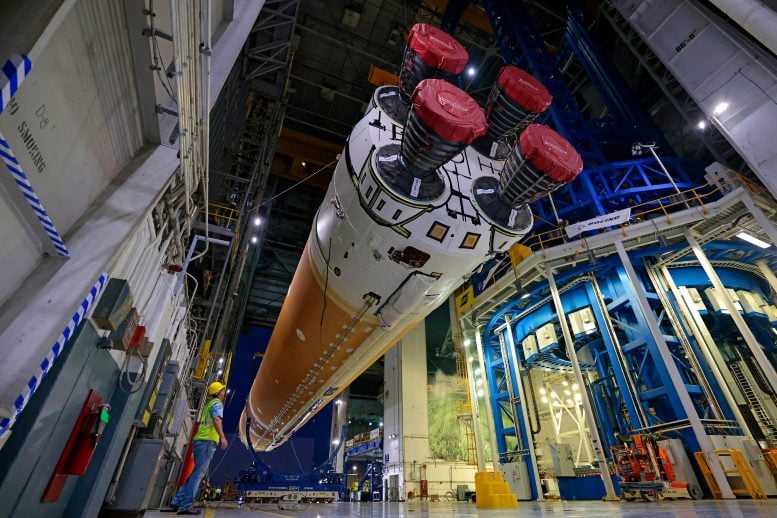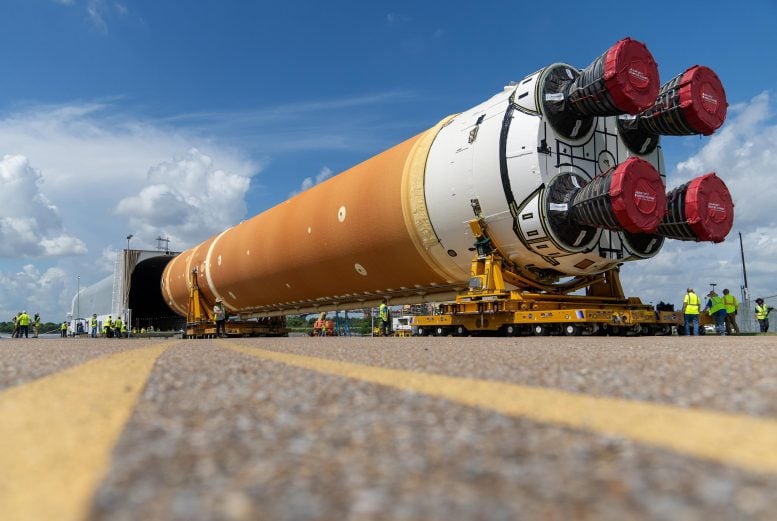
NASA’s Pegasus barge, carrying the agency’s massive SLS (Space Launch System) core stage, arrives at NASA’s Kennedy Space Center Complex 39 turn basin wharf in Florida on Tuesday, July 23, 2024, after journeying from the agency’s Michoud Assembly Facility in New Orleans. The core stage is the next piece of Artemis hardware to arrive at the spaceport and will be offloaded and moved to NASA Kennedy’s Vehicle Assembly Building, where it will be prepared for integration ahead of the Artemis II launch. Credit: NASA/Kim Shiflett
ASA’s Space Launch System (SLS) rocket core stage for the Artemis II mission arrived at Kennedy Space Center, having been transported from Michoud Assembly Facility in New Orleans.
This crucial component, integral for the first crewed flight around the Moon with the Orion spacecraft, spent seven days in transit through the Gulf of Mexico and the Atlantic Ocean.
NASA’s powerful SLS (Space Launch System) rocket core stage for the Artemis II mission arrived on Tuesday, July 23, at the agency’s Kennedy Space Center in Florida. The core stage will help power SLS when it launches four astronauts around the Moon for the first crewed flight of SLS and the Orion spacecraft during the Artemis II test flight.
The core stage, aboard NASA’s Pegasus barge, traveled from the agency’s Michoud Assembly Facility in New Orleans and spent seven days coasting through the Gulf of Mexico and then the Atlantic Ocean before arriving at NASA Kennedy’s Complex 39 turn basin wharf.

Technicians at Michoud Assembly Facility in New Orleans lift the core stage that will help launch the first crewed flight of NASA’s SLS (Space Launch System) rocket for the agency’s Artemis II mission. Teams at Michoud lifted the core stage on Thursday, July 11, 2024, onto NASA’s Multi-Purpose Transportation System, designed to transport SLS vehicle segments by waterway and roadway. It is tasked with transporting the vehicle from where it is manufactured to its intermediate test location and final launch destination. The core stage was lifted in preparation for its move onto the agency’s Pegasus barge, where it will be ferried to NASA’s Kennedy Space Center in Florida. Credit: NASA/Michael DeMocker
The 212-foot-tall SLS core stage, its propellant tanks, avionics, flight computer systems, and four RS-25 engines, were manufactured and assembled at NASA Michoud. Now, teams with NASA Kennedy’s Exploration Ground Systems Program will prepare the rocket stage for integration ahead of launch.
The only rocket that can send the Orion spacecraft, astronauts, and supplies to the Moon on a single launch is the Space Launch System. Its core stage provides more than two million pounds of thrust and the whole rocket provides 8.8 million pounds of thrust to launch Artemis II to the Moon.
Up next, the core stage will roll to NASA Kennedy’s Vehicle Assembly Building, where teams will process it until it is ready for rocket stacking operations.

Move teams with NASA and Boeing, the SLS core stage lead contractor, position the massive rocket stage for NASA’s SLS (Space Launch System) rocket on special transporters to strategically guide the flight hardware the 1.3-mile distance from the factory floor onto the agency’s Pegasus barge on July 16. The core stage will be ferried to NASA’s Kennedy Space Center in Florida, where it will be integrated with other parts of the rocket that will power NASA’s Artemis II mission. Credit: NASA
NASA’s Space Launch System (SLS) represents a critical component in the United States’ contemporary space exploration framework, designed as the most powerful rocket ever built. This colossal launch vehicle is engineered to enable astronauts and large payloads to undertake deep space missions, including trips to the Moon and potentially Mars. The SLS is a key part of NASA’s Artemis program, which aims to return humans to the lunar surface and establish a sustainable presence there. Its development leverages technology and infrastructure from the Space Shuttle and other exploration programs, thus embodying a blend of proven engineering and cutting-edge advancements.
The SLS rocket comprises several parts, including a core stage that houses the rocket’s main engines and fuel tanks, solid rocket boosters for additional thrust, and an upper stage that varies depending on the mission’s specific requirements. The core stage of the SLS is equipped with four RS-25 engines, remnants of the Space Shuttle program, which together generate incredible power to lift heavy payloads into space. Capable of producing up to 8.8 million pounds of thrust, the SLS can carry more than 27 metric tons to orbits beyond the Moon, making it a cornerstone in NASA’s strategy for deep space exploration and science missions.









Be the first to comment on "NASA’s Artemis Rocket Core Stage Journeys to Florida"